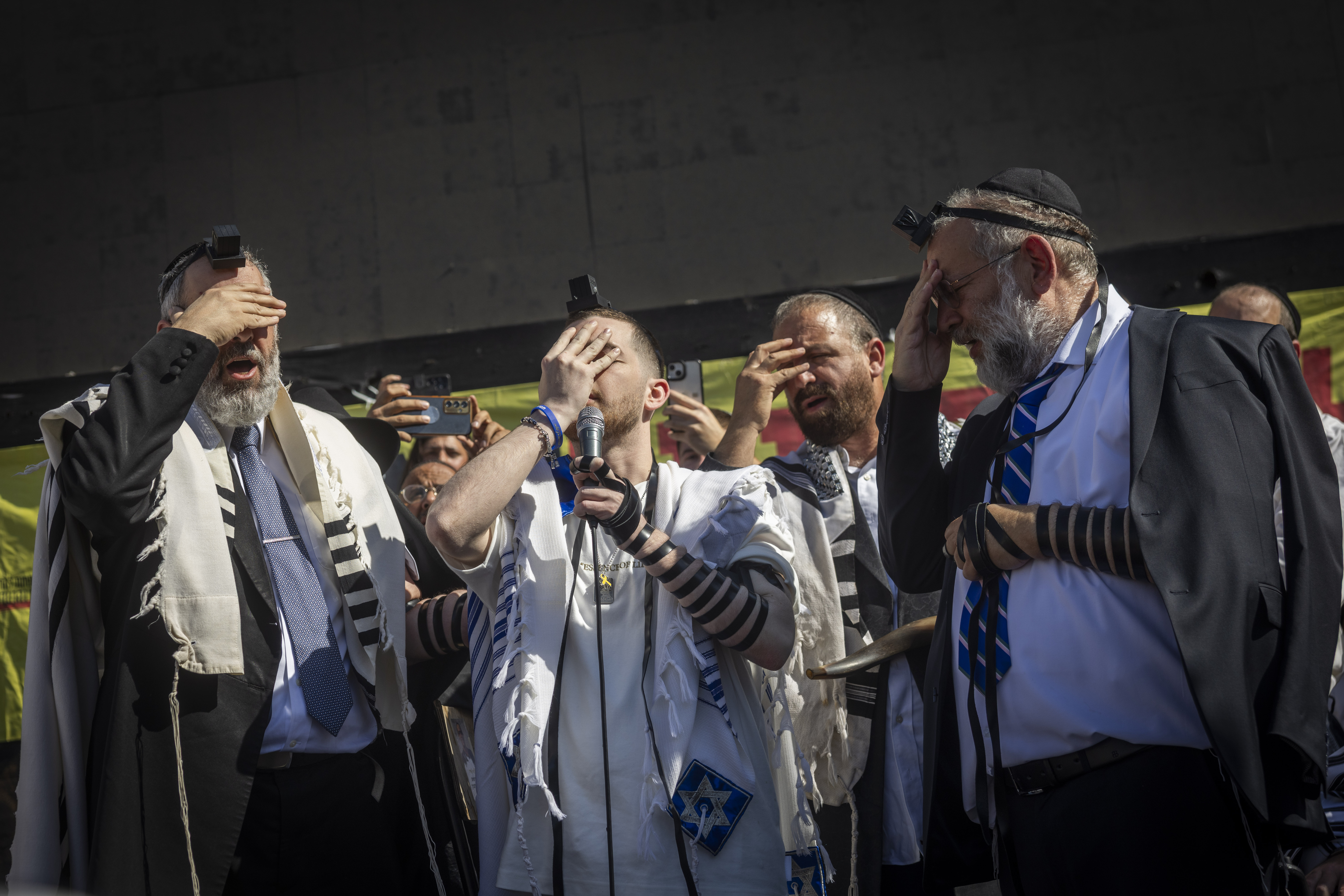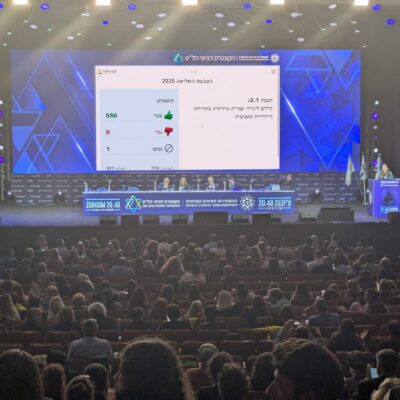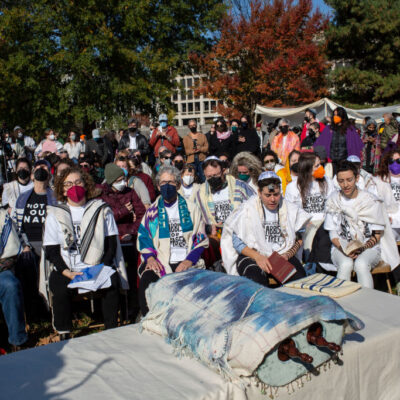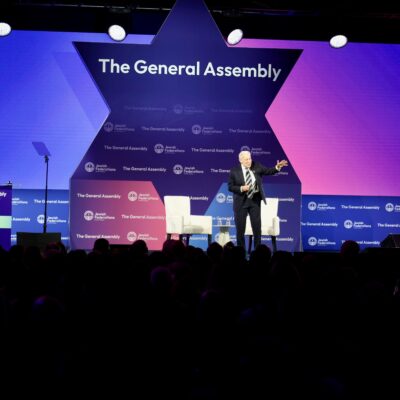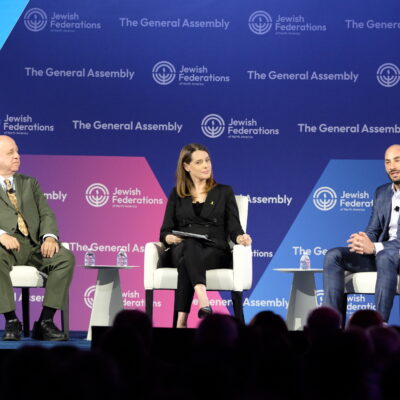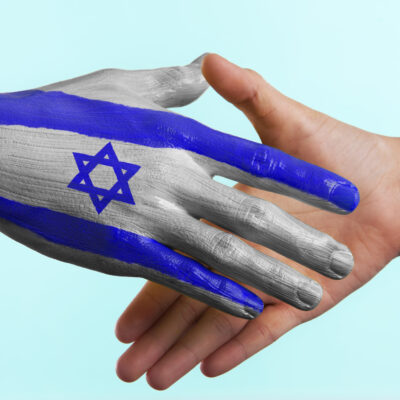RABBINIC JUDAISM
Atra study provides rare, caveated glimpse into the U.S. rabbinate, offering insight and concern
Survey finds rabbis increasingly shying away from pulpit posts, seeing them as too demanding, and that majority of rabbinical students are LGBTQ+

Probal Rashid/LightRocket via Getty Images
People attend a 'Rabbis for Ceasefire' prayer service to pray for a ceasefire in Gaza, near the U.S. Capitol in Washington, on Nov. 13, 2023.
Rabbi Amichai Lau Lavie is taking a moment to celebrate. It may not last.
A recent study looking at current and future rabbis released last Wednesday by Atra – Center for Rabbinic Innovation found that 51% of current rabbinical students identify as LGBTQ+, including 12% who identified as trans or nonbinary. There are caveats and criticisms of these statistics, namely that they do not include Modern Orthodox rabbinical students and that they bunch together substantially different seminaries that do not belong in the same group.
Yet the findings of the study — “From Calling to Career: Mapping the Current State and Future of Rabbinic Leadership” — indicate a non-Orthodox rabbinate whose demographics are substantially different from the non-Orthodox Jewish population that it will serve. Several leading figures within the Jewish communal world told eJewishPhilanthropy that these findings are both a symptom of and a contributor to a progressive drift among non-Orthodox denominations, which may put them at odds with mainstream Jewish communal organizations. They added that it will make it far more difficult for rabbinic programs to receive the philanthropic support that they require.
These figures, speaking on condition of anonymity for fear of being criticized as homophobic or otherwise bigoted, stressed that the issue is not the acceptance of LGBTQ+ students into rabbinical schools, which they said that they wholeheartedly welcomed, but the significantly disproportionate amount. This, they said, indicates that the rabbinate is increasingly perceived as a counter-cultural career choice, which does not bode well in terms of financial support from the typically more mainstream donor class.
As a member of the first generation of openly queer rabbis, Lau Lavie, 56, paved the way for the influx of LGBTQ+ rabbinical students. He also helped shatter denominational walls by co-founding Manhattan’s experimental Lab/Shul community. He fears that the progress that has been made will contribute to a conservative backlash.
Experts told eJP that the study, which was performed by Rosov Consulting, has significant flaws, especially related to information on the Orthodox community, but stressed that it includes important findings that offer a critical window into understanding the non-Orthodox American rabbinate. Chief among them is that rabbis are increasingly choosing community positions rather than leading congregations from the pulpit, as well as the rise in LGBTQ+ rabbis and in the number of nondenominational schools that ordain rabbis.
The discrepancies were why Rabbi Shua Brick, who is considered the first openly gay Orthodox congregational rabbi, grew concerned when he saw peers posting data from the survey online, especially the statistics about LGBTQ+ rabbinical students. In both Atra’s press release and summary on their website, it was not clear that the study of current students did not include the vast majority of Orthodox rabbis-to-be. Instead, the 51% figure was presented as if it encompassed all current rabbinical students, with the exception of Haredim. Even Lau Lavie initially wrote about the figure, thinking that it represented all rabbis, not non-Orthodox rabbinical students.
When someone posts the survey’s central finding “without disclaimers, it feels immediately silly because that’s obviously not true,” Brick told eJewishPhilanthropy. Doing so not only causes people posting the 51% figure to lose credibility, but the statistic also divides the Jewish community by not including Orthodox Jews.
The study, funded by the H&F Baker Foundation, the Jim Joseph Foundation and Mandel Foundation, was prompted after philanthropist Heather Baker was moved by a 2022 sermon by Rabbi Elliot Cosgrove of Park Avenue Synagogue, a Conservative congregation, about the lack of new rabbis entering the field, suggesting that there was a rabbinic pipeline problem, which would leave many congregations without a spiritual leader when their current rabbi retires.
Brick, who has participated in Atra programming in the past, said that the organization, which trains and supports rabbis across denominations, is generally committed to Orthodox rabbis as well, which is why he was disappointed more weren’t involved in the study, especially current students. “It felt very silly that Yeshiva University didn’t participate,” he said. He was ordained at YU’s Rabbi Isaac Elchanan Theological Seminary, which produces approximately 50 new rabbis per year. Rabbi Shira Koch Epstein, executive director of Atra, confirmed that YU, which is listed as an Institutional Partner in the study, was asked to participate in the current student portion of the study, but ultimately didn’t, adding, “We have a good relationship with Yeshiva University as an organization, and so… I don’t know that it’s that they wouldn’t participate in some kind of negative way.”
The Orthodox community has a pipeline problem, too, Brick noted. “From [YU’s] perspective, it would have been really nice to get so much free work and free labor to find out about their students,” he said. When he began his studies at YU, there were 80 students in his introduction classes, but when he graduated in 2021, only eight participated in internships to prepare for pulpit jobs post-ordination– only half of whom actually became congregational rabbis, with the rest going into education roles.
“The study had to be bounded in some ways,” Wendy Rosov, the lead researcher and founder of Rosov Consulting, told eJP. The parameters that were set excluded rabbis and students in the Haredi community, including Chabad, according to Rosov and Koch Epstein, because of their lack of access to Haredi communities and as Haredi communities use a different system for recruitment, placement and training rabbis than other denominations.
“The distinctions between the Haredi and the non-Haredi world are well enough known that this would have been a very different study,” Rosov said. “It would have been its own study, frankly.”
Although the researchers decided against including Haredim, they said that they did seek to include Orthodoxy. But experts in the Modern Orthodox community told eJP that their numbers were likely severely undercounted. For instance, the study showed that there are 353 Modern Orthodox working rabbis working in America compared to 1,445 Reform working rabbis, 1,050 Conservative working rabbis, 465 nondenominational working rabbis and 304 Reconstructionist working rabbis.
However, the figure of 353 Modern Orthodox working rabbis was provided by the Rabbinical Council of America, one of several Orthodox organizations, which told eJP that they assumed there were many more working Modern Orthodox rabbis in the field than the number they provided. The RCA told eJP that their membership numbers do not represent all Modern Orthodox rabbis; most notably, they don’t represent rabbis who work outside of the synagogue, including in schools. The study itself included a disclaimer saying, “RIETS and HTC did not independently provide data; therefore, estimates of their numbers rely on data provided by RCA, which may not include all ordained rabbis currently working in ‘rabbinical careers.’ Additionally, the extent to which we have fully captured those with non-Haredi private semicha cannot be confirmed.”
Although there are no official current statistics available, a Modern Orthodox leader told eJP that the 353 figure is fewer than the number of Modern Orthodox rabbis estimated to be working in the New York Metropolitan area alone.
The study may have other flaws and omissions, observers suggest. Most notably, despite the issue of Israel and Zionism being hotly debated within the Jewish world, there is scant mention of the topics, with only a brief mention of the fact that Zionism is not a major motivator for going into the rabbinate.
One of the challenges of studying Orthodox rabbinic training, Adam Ferziger, professor in the Israel and Golda Koschitzky Department of Jewish History and Contemporary Jewry at Bar-Ilan University, told eJP, is that many working American Modern Orthodox rabbis receive ordination in Israel.
“Either they should have decided to collect more data from the Orthodox or they should have just left them out completely,” Ferziger said, believing that the study should be presented as an analysis of the non-Orthodox rabbinate. “They ought to change the cover [of the report to say it is a study of only non-Orthodox rabbis], but I don’t think that… it undermines the overall value of the study.”
Despite the problems, there is a lot to learn from the report, experts agreed, including that day school experience is increasingly becoming a predictor of future rabbis, while participation in camp, youth groups or Hebrew school is becoming less so. While 97% of current rabbis find their work rewarding, the workforce is aging, with only 6% under 35, and more rabbis are choosing non-congregational roles over pulpit roles, despite lower pay. This is because pulpit positions are seen as emotionally taxing with blurred boundaries and unrealistic expectations. The study also showed that 66% of current rabbinical students are entering the field after leaving another career.
“What I hope people really do take from it is trying to think about, ‘How do we make sure that [the job of being] a rabbi is sustainable?’” Brick said. “A lot of that is actually more about communities and [what] they want from their rabbis and being ready as a community to decide that they want to treat their rabbis in a different way, in a better way.”
Still, it’s the LGBTQ+ statistic that is gaining the most attention, even though the study cautions it “may be an overestimate.”
From a demographic standpoint, the 51% figure does not align with the Jewish community’s overall makeup. A 2020 Pew study showed 9% of American Jews identify as LGBTQ+ and 25% of those under 30 identified as such. The study also shows that 12% of current students identify as trans or nonbinary — a figure that has quadrupled over the past 10 years — while less than 1.6% of Americans identify as such, according to a 2022 Williams Institute study.
In contrast, the study found that there is near gender parity among non-Orthodox rabbis — 53% male rabbis, 46% female rabbis — bringing the figure closer in line with the share of women in the population.
Historically, the LGBTQ+ community has been underrepresented in the rabbinate. For Brick, LGBTQ+ rabbis are “perfectly suited for communal work, because they believe in community the most,” he said. “People who have gone through an experience of coming out… know what it means to really care and be intentional about the people you have around you and to really see people’s needs.” Lau Lavie sees this as a group of wounded healers, turning their pain into empathy to help others.
At Yeshiva University, Brick estimated that 25% of former student council presidents came out of the closet after graduating, just as he did. Because they feel ostracized, he posited, they feel the need to overachieve. “A lot of queer individuals in the Jewish community want to belong, are incredibly dedicated to the Jewish community, and really want to be there… I hope the Jewish community would appreciate that queer people are not liabilities to worry about, that they actually could be incredible contributors and some of our most wonderful rabbis,” Brick said.
For many in the Jewish community, the large number of LGBTQ+ rabbinical students really isn’t an issue, Ferziger said. “It seems to me that outside the Orthodox world, for most American Jews, especially those below 50, [being] LGBTQ is a non-issue. Egalitarianism prevails in every way… In practice, the new data offers an opportunity for a longitudinal study to see where these rabbis land in 10 years, in the community or in the pulpit.”
Still, senior figures within the Jewish community raised concerns to eJP that the results may make it more difficult for non-Orthodox rabbinic programs to receive funding.
“I think anyone who actually was donating or cared about these rabbinical schools or anyone who’s been in these classes anytime recently will not be surprised by any of these statistics,” Brick said. “I don’t think it’ll change any donor’s minds.”
That these statistics won’t change the minds of donors may precisely be the problem, however, as most of the seminaries mentioned in the report are facing increasingly dire funding shortages, with many forced to sell off property and dip into their endowments to stay afloat in recent years. Indeed, Atra was formed in large part because of the lack of interest in the rabbinate by Jewish philanthropy.
This concern over funding for non-Orthodox schools and organizations has been growing, especially as some — such as the Reconstructionist movement — are being accused of cultivating anti-Zionism. Since the Oct. 7 terror attacks and the explosion of antisemitism on college campuses that emerged from it, Hillel International, which employs many rabbis, has come under growing fire for being too progressive and accepting of anti-Zionism, most recently in a cover story in the conservative Jewish magazine Commentary.
Jewish donors, who generally belong to an older generation that puts great significance on Israel and Zionism, are unlikely to offer robust support to institutions that they believe will produce rabbis who do not hold the same values.
Both Koch Epstein and Rosov said that they stand by the universal title of the report and that its findings speak to the entire Jewish community, not just non-Orthodox sects, and that they were transparent within the study about what was included and not included, with disclaimers throughout the 102-page study. Legally, they said, Atra and Rosov were not able to break down the demographics about specific institutions because the researchers agreed to shield data from rabbinical schools related to gender, race, sexuality or whether students were born Jewish. As a result, all of the schools were bundled together.
Lau Lavie said that this outcome is positive, even if only symbolic, because he has been advocating for non-Orthodox rabbinic schools to merge since his time studying at the Jewish Theological Seminary in New York City, the Conservative movement’s flagship institution. He left the denomination in 2017 over its ban on interfaith marriages.
“We are working unwisely by not consolidating the liberal rabbinic education. We’re spending all this money on different campuses and not huge differences,” he said. “The consistent wave that this report is looking at is the move from a very rigid, male-driven Judaism, I would hesitate to say, patriarchal, to a less male-driven Judaism and to a gradually post-patriarchal Judaism.”
Denominations, he said, are a recent invention, formed in the 19th century, so it’s natural they would shift again. Drawing a parallel with how people today consume media and entertainment, Lau Laive said, “ABC, CBS, NBC, who cares? We’re all on Netflix or Hulu.”
The turn away from denominational seminaries is often based on convenience, not ideology, Ferziger said. People are choosing to study online or close to home instead of moving to study at JTS or the Reform movement’s Hebrew Union College-Jewish Institute of Religion campuses in Los Angeles or New York.
This may not signify an end to denominations, Ferziger said, but “it does mean that because the distinctions between the various non-Orthodox movements aren’t very great from a demographic perspective in terms of the communities and who attends the different synagogues, it’s a much less ideological decision.”
No longer are synagogues insisting that rabbis come from schools officially administered by their denomination, he said. It’s becoming more common for a Conservative synagogue to hire a rabbi ordained from nondenominational schools, which are now training 42% of non-Orthodox rabbinical students. Similarly, Ferziger noted, there are more Modern Orthodox synagogues hiring Chabad rabbis.
“Yes, [congregations] want people to be credentialed and they want people to have certain training,” Ferziger said, “but at the end of the day, what they care most about is finding rabbis who have the knowledge and the skill sets that will meet the needs of the community.”
Lau Lavie argues that the surge of LGBTQ+ students is simply “compensation” for the years gays, lesbians and transgender people haven’t been allowed into rabbinical schools. The genie can’t be put “back in the bottle,” he said, but he is worried about the counterpendulum that will swing from the right.
“Am I concerned that the male-driven Judaism that still considers women to be back of the bus and won’t allow LGBT people to be part of the leadership, let alone allowed in the community? Yes,” he said, pointing to the current political and religious pull to the right in America and Israel, which is why he is “holding on to the 51%.”
Koch Epstein lamented the focus on “one or two statistics when we have 90 pages of data on why rabbis do and don’t serve, where they serve, what denominations they are, where they are in the country, where the decline and the growth in the seminaries are?”
She added: “at least they’re paying attention and want to care, so I guess I shouldn’t be frustrated [that] everyone’s focused on one demographic if it means that they care about the future of rabbinic leadership.”
This is a moment to savor, Lau Lavie said, because there are passionate students coming into the rabbinate. “I’m getting a lot of people who come to me who are younger, who are not necessarily queer, but also I get people who are ex-Haredi or coming from no background, who are usually very young, who want advice about joining rabbinical school, who are excited that they have more options to let their voice be heard and to become partners in charting the way forward.”

 Add EJP on Google
Add EJP on Google